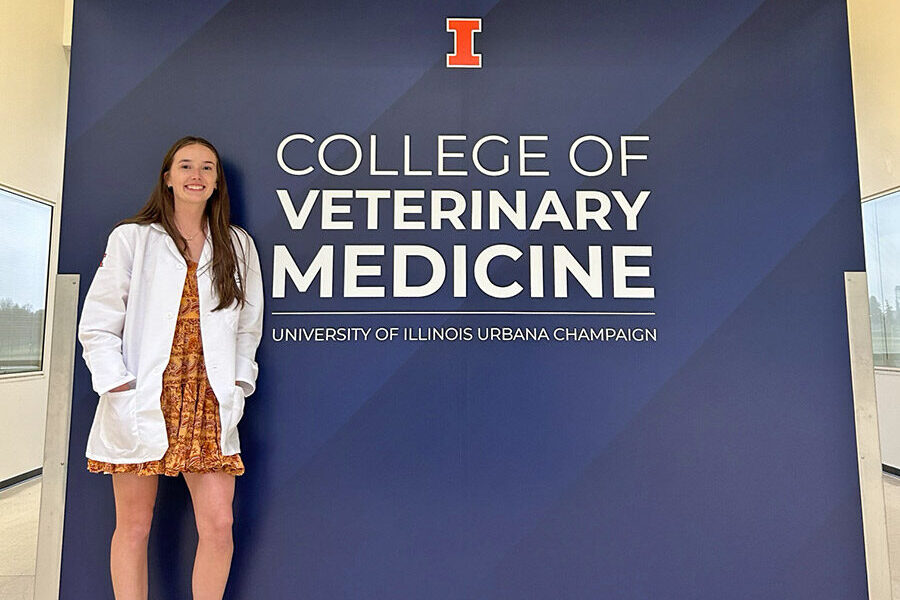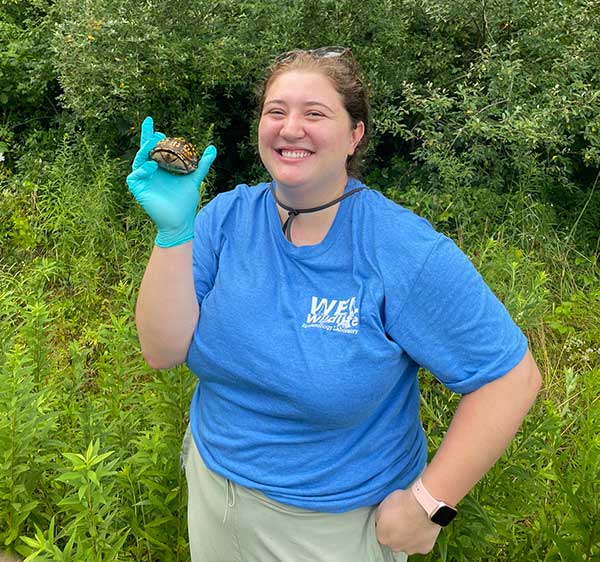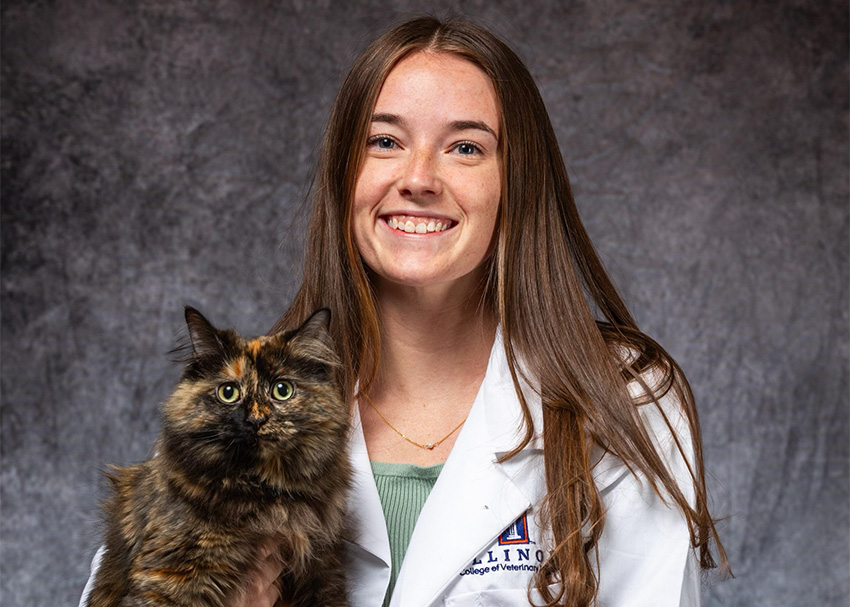Willkommen in Deutschland
In June 2019, I had the utmost pleasure to study pathology under the leadership of Prof. Dr. Jens Teifke in the Department of Experimental Animal Facilities and Biorisk Management at the Friedrich-Loeffler-Institute (FLI) on Riems, an island near the city of Greifswald, Germany. (The Island of Riems, on the northeastern coast in the Baltic Sea, is connected to mainland Germany via a small causeway, which may be closed in the event of an outbreak.) Given my career interest in infectious disease, I chose to study at the FLI not only for its prestige and the cutting-edge research conducted there, but also to gain experience working in high biocontainment facilities and diagnosing high-impact infectious diseases that are rarely seen in the United States.
![[Friedrich Loeffler Institute]](https://vetmed.illinois.edu/wp-content/uploads/2021/04/sb-holland-bldg.jpg)
![[Loeffler-Haus]](https://vetmed.illinois.edu/wp-content/uploads/2021/04/sb-holland-house.jpg)
Since its founding over a century ago, the FLI has continued Loeffler’s work by maintaining active FMD research and has expanded to become one of the world’s largest infectious disease institutions. During its history, the FLI at Riems acquired the moniker the “island of plagues” (or, as the FLI president noted, a “pathogenicity island,” which still makes me smile), and currently conducts research into FMD, African Swine Fever (ASF), Ebola, Nipah, Rift Valley fever, bovine spongiform encephalopathy, bluetongue, rabies, Q-fever, influenza, Yersinia pestis, Francisella tularensis, Bacillus anthracis, as well as infectious diseases unique to fish, molluscs, crustaceans, and bees, and non-infectious animal health issues, including nutrition, welfare, and husbandry. The sheer breadth of research conducted at the FLI is profound, with tremendous collaborations, and the overarching goal to improve animal, human, and global health.
Although the United States is currently free of FMD and ASF, the risk of transmission is always present due to international trade and movement between countries. As a future veterinarian, I feel an obligation to be able to recognize, diagnose, and respond to major diseases that pose a threat to animal, human, and environmental health.
It is one thing to learn about FMD and ASF in a textbook and in class, but it is quite another to monitor animals daily and see them transition from healthy to clinical disease. During my time at the FLI, I saw firsthand, worked with, and assisted in collecting samples from and performing necropsies on cattle and wild boars experimentally infected with the FMD and ASF viruses. (In the photo at the top of the page, I am with an international team of veterinarians and scientists and we are discussing our approach to the final necropsy of a wild boar experimentally infected with a Belgian strain of the ASF virus.) I learned how these diseases are managed, controlled, and diagnosed in real-world scenarios, their prevalence globally, and their potential for economic impact if outbreaks were to occur in a naïve population.
And from a purely scientific curiosity standpoint, I had countless conversations with some of the world’s leading experts in FMD and ASF on the major directions of current and future research not only to control and combat these high-impact pathogens, but also to understand the sheer beauty and elegance of these host-pathogen interactions, unexplained phenomena in pathogenesis and lesion development, and peculiar variability observed within infected herds.
![[Robin Holland-right-in a German slaughterhouse]](https://vetmed.illinois.edu/wp-content/uploads/2021/04/sb-holland-slaughter-240x300.jpg)
For rigorous pathology training, alongside brilliant veterinary pathologists and technicians, I learned how to process samples for high quality histopathological analysis and how to characterize and describe various lesions scientifically and succinctly. I assisted in writing case and necropsy reports, including the case submissions for the US Joint Pathology Center (US Armed Forces Institute of Pathology) Wednesday Slide Conference training year 2019-20. This included microscopic descriptions and morphologic diagnoses, literature reviews, and case histories on avian tuberculosis and foot-and-mouth disease.
Given my career interest to study infectious diseases, I also sought to learn how high-level containment facilities are managed and how biosecurity is maintained. Alongside engineers and biorisk officers, I saw the massive infrastructure of the FLI, including HEPA filtration of exhaust air, room decontamination by dry fogging, waste water treatment, and carcass rendering to animal byproducts. I learned how the level 2 through 4 facilities are managed, protocols for containment in the event of an emergency, and how facilities are designed and personnel are trained in order to ensure that—especially considering work with highly contagious pathogens such as FMDV—all pathogens are contained within the facility.
Interestingly, I also came to appreciate that there is simply no single blueprint for how high containment infectious disease animal facilities are built. Thus, I was in awe of the truly incredible engineering marvel that keeps the FLI in operation, and the brilliance and creativity of the architects, engineers, and other scientists who designed the FLI.
My experiences at the FLI were beyond expectation. The FLI is a premier institution that holds scientists to the highest standards in order to produce meaningful and impactful research, all while maintaining a collaborative, welcoming environment.
The FLI also values transparency, and during my time at the institution, I met members of the German Ministry seeking to learn about the FLI’s occupational health and safety practices, as well as a group from Australia seeking to build a BSL-4 facility. During those experiences, individuals from the FLI were fully open regarding the design of their institution, their management protocols, and the type of research being conducted.
The FLI is wonderfully amenable to outside guests, as I was able to stay on the island, and I always felt welcomed. To anyone with an interest in pathology, infectious disease, public health, or biorisk management, I highly recommend visiting the FLI. I am incredibly grateful to every individual that I had the utmost privilege to work with, and for the tremendous education that I received on this little Baltic island.
Dankeschön!
—Robin Holland, PhD, DVM Class of 2020

![[Robin Holland necropsies wild boar at German research institute]](https://vetmed.illinois.edu/wp-content/uploads/2021/04/sb-holland-fli.jpg)


